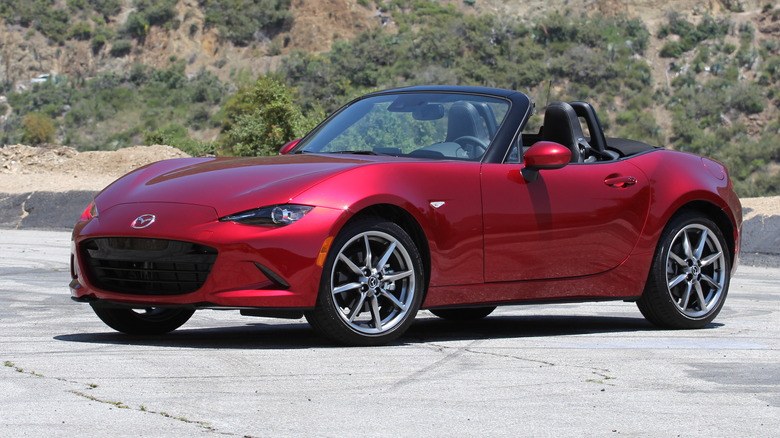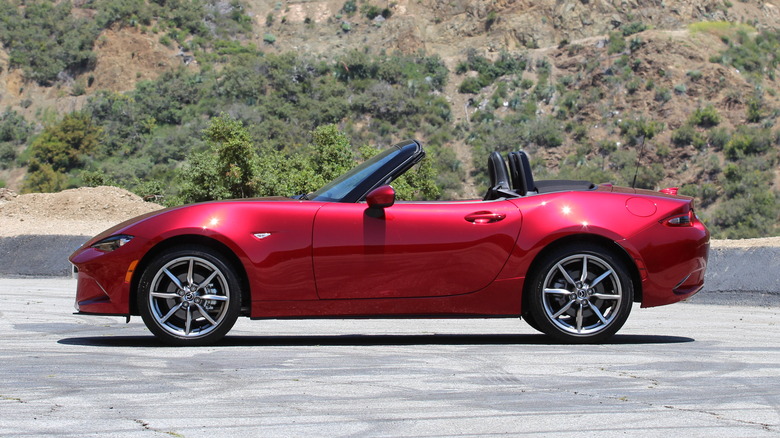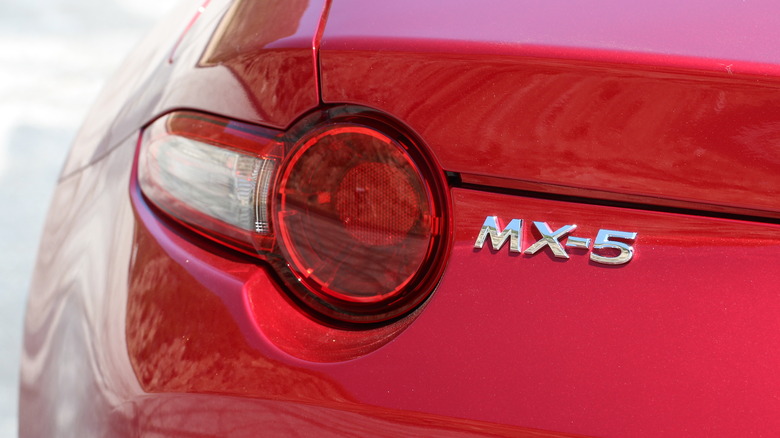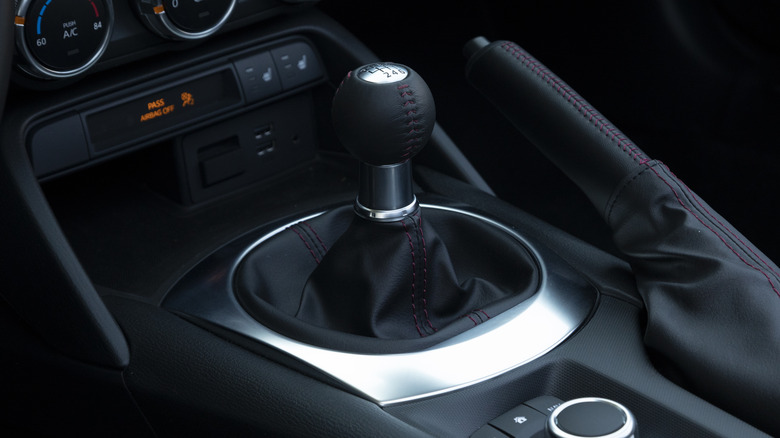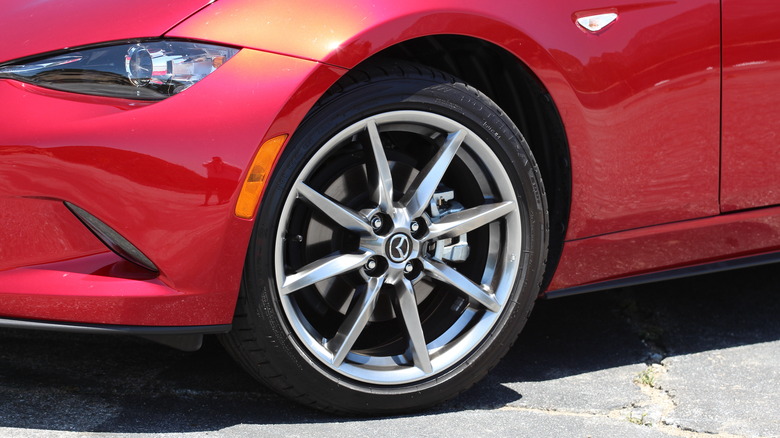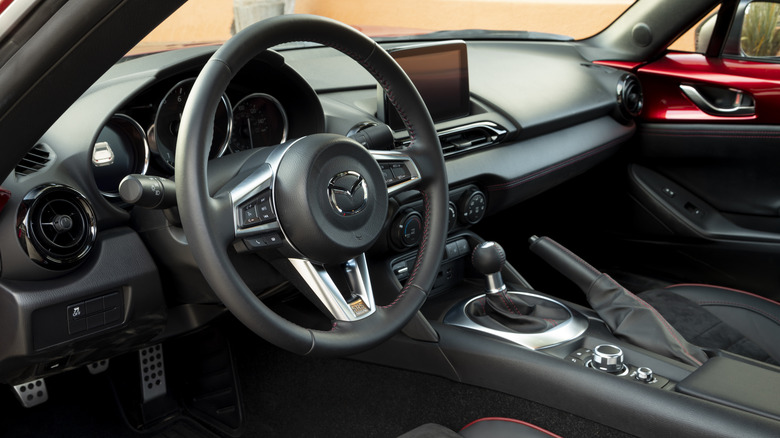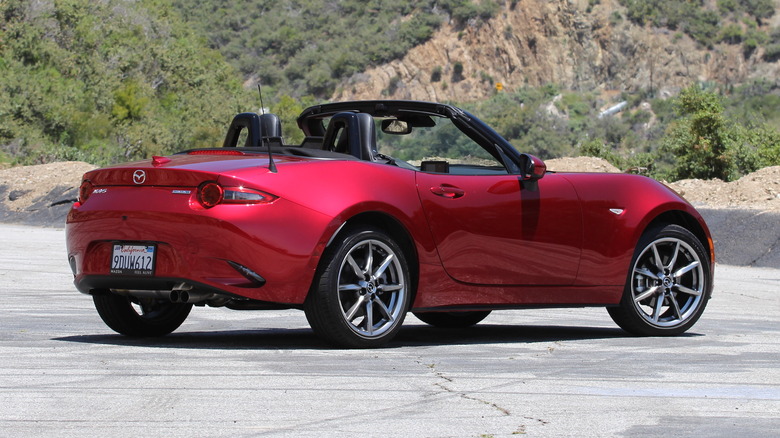2023 Mazda MX-5 Miata Review: A Recipe For Happiness
- Perfectly balanced handling
- Just enough power
- Top flips back in seconds
- Outdated multimedia software
- Touchscreen only works when stopped
- Overprotective blind-spot monitoring
In June 2020, I bought a 1999 Mazda MX-5 Miata – a little pandemic present to offset the constant "oh god, we're in this forever, I need to disinfect all my groceries and lock the windows" thoughts. In the three years since bringing the Miata home, it's proven to be the gift that keeps on giving. It's as charming as it is slow, and perfect for bombing around Los Angeles. The Miata is a go-to shot of endorphins for days when I'm feeling low.
And you know, time's been good to the Miata. Behind the wheel of a 2023 MX-5 Grand Touring, the roadster's quintessential spirit of playfulness is alive and well. I can jump back and forth between my '99 10th Anniversary Edition and the new Miata and genuinely feel the lineage. The new MX-5 is the same sprightly smile factory it's always been.
What's new for 2023?
Mazda added a new color — Zircon Sand — to the Miata's color palette this year. I've seen a few running around, and this silvery-beige hue actually looks pretty rad on the MX-5. That's really all that's changed for the Miata this year, and honestly, that's fine. The best thing about the Miata isn't what's new, it's what's been there all along.
The Miata still comes two ways, as a soft-top roadster or a coupe with a power-retractable roof (which I want to call a Targa, but Porsche will get mad). You need at least $29,215 — including $1,165 for destination — to get into the standard MX-5, while opting for the hard-top Miata RF costs a minimum of $36,915. Why the major price discrepancy? The fabric-roof Miata has an entry-level Sport trim, while the RF only comes in the mid- and high-tier Club and Grand Touring variants. Plus, the RF Club comes standard with Brembo brakes, BBS wheels, and Recaro seats that are optional on the roadster.
Soft top or hard top?
I totally get the merits of the Miata RF, especially as a daily driver, since it offers slightly better insulation from the outside world and has a cool look all its own with the roof up. But to me, the Miata is a roadster above all, and I love being able to just unlatch the roof and toss it back with one hand. Fun fact: Mazda actually designed the seats to have less bolstering around the shoulders to make it easier for passengers to click the roof down into its stowed position.
The standard Miata has a teensy-tiny bit more cargo room than the RF in its teensy-tiny trunk: 4.6 cubic feet, compared to 4.5. The soft-top Miata is also a skosh lighter than its hard-top sibling, though really, the 111 pound difference is imperceptible from the driver's seat.
It's not about the power
The Miata's engine has never been its star quality. Sure, the modern MX-5's 2.0-liter naturally aspirated inline-4 is fine, making a perfectly adequate 181 horsepower and 151 pound-feet of torque. But, like, my '99 Miata only made 140 hp when new, and I legitimately do not think this car needs more oomph. It's a momentum car. I'll explain in a moment.
Six-speed manual and automatic transmissions are offered, but I have exactly zero experience with the latter, and I intend to keep it that way. I get that not everyone can drive a stick and there's clearly a market for an automatic Miata, but there isn't a world where I'd ever consider buying one of these without the manual, and I strongly urge you to do the same. The clutch is super forgiving and the shifter is pretty much perfect. This would actually be a great car in which to learn how to drive a stick.
Because the Miata isn't a powerful little thing, the upside is that it's somewhat economical. According to the EPA, you can expect to see 26 mpg city, 34 mpg highway and 29 mpg combined in a manual Miata, while automatic variants should return 26 mpg city, 35 mpg highway and 30 mpg combined. Even so, get the manual.
The momentum car
The Miata is not a stiffly sprung car with flat-as-a-pancake cornering abilities. Instead, it does an excellent job communicating a sense of speed to the driver, making you feel like your pelvis is part of the chassis, and really getting a sense of how much grip is available at each corner. This car isn't about pushing things to the limit – it's about carrying speed through sweeping turns and stringing the apexes of corners together like a game of connect the dots.
The base Miata Sport has 16-inch wheels that are actually kind of cute, but Club and Grand Touring trims up those to 17-inchers, wrapped in Bridgestone summer tires. Wheel-and-tire packages are a common Miata upgrade, and I adore when people put slightly wider wheels and fatter tires on their cars. Or maybe I'm just saying that because I swapped out the original 15x6-inch chrome wheels from my 10th Anniversary Miata for a set of bronze 15x7 Enkei RPF1s with 205-section tires.
Manual Miatas come with an electronic limited-slip differential that helps to manage power delivery across the rear axle, and it really does improve this roadster's already stellar handling. It's easy to feel confident while driving the Miata on a winding road, and it's nice knowing you don't have to push this car to definitely not-legal speeds just to feel that sense of excitement. Slow car fast is always more fun than fast car slow.
Steering? Light and flickable, with lots of communication about what's happening at road level. Brakes? Secure and confident, even if you don't get the Miata Club's Brembo stoppers. Wind buffeting? Honestly, it's not that bad, mostly because Mazda designed the MX-5's body and windshield to channel air up, over and around the cockpit. You can easily hold a conversation with a passenger at 70 mph on the freeway.
A minimalist interior, for better or worse
Look, considering the size of this car, you can't expect things like big storage spaces, deep door cubbies, or lots of cup holders. There's a small compartment in the center console big enough to hold the key fob, and a larger makeshift-glovebox between the two seats – just like in my '99 Miata. The small slot ahead of the gear shifter isn't actually large enough to accommodate a modern iPhone, and there are only USB-A outlets, not USB-C, partially showing the ND-generation's age.
But, I mean, who cares? It's a Miata. The leather surfaces feel nice and the seats are supportive — especially if you get the Club's optional Recaros. All the climate controls are logically arranged and easy to adjust on the fly, and the steering wheel only has a few buttons and toggles.
My biggest complaint with the Miata is its crap-tastic infotainment system, where the tough-to-navigate Mazda Connect software is housed in a 7-inch display. (Thankfully, you can run Apple CarPlay or Android Auto instead.) This screen easily washes out in sunlight, which is a very frequent problem in a convertible, and while it is a touchscreen, it only responds to touch while the car is stopped. When driving, you're forced to use the rotary control knob on the console, which is annoying since this still requires you to take a hand off the wheel.
2023 Mazda MX-5 Miata verdict
Despite its minor shortcomings — like one of the most overprotective and annoying blind-spot monitoring systems ever made, and the nannying infotainment touchscreen lock-out — it's impossible to dislike the Miata. It's more fun than sports cars costing two or three times as much money, and proof that a high-powered engine and super-stiff chassis aren't required for a car to be a thrill.
A loaded MX-5 Grand Touring like my Soul Red test car comes in at $36,370, but you really don't have to pay that much money to get a really great Miata. A base Sport will treat you just as well for thousands of dollars less. Or, you know, a $10,000 used Miata you can find on Craigslist. New or old, the Miata's intrinsic joy remains the same.
